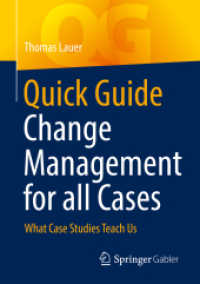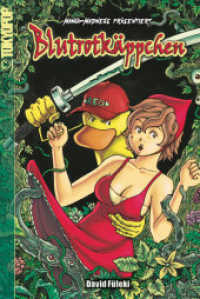Full Description
The authoritative general introduction to cognitive linguistics
Vyvyan Evans covers all aspects of the relationship between language and mind, as well as applications and extensions of cognitive linguistics to the study of text, literature, discourse, and society.
Bursting with new content and presented in a new 5-part structure, the book has been fully revised and extensively updated throughout to deliver the complete guide to the cognitive linguistic enterprise. Brand new additions include: an innovative new chapter exploring key topics in language science, a new chapter introducing the range of research methods and approaches for studying human language, mind and behaviour and new chapters exploring areas such as access semantics and meaning construction, conceptual structure, the nature of space, time, gesture and sign language.
Key features include:
30 fully revised chapters in five coherent parts, including 7 entirely new chapters Discussion questions and annotated reading list at the end of each chapterCritical evaluation and reflection on influential cognitive linguistic theories, and how they compare to formal approaches in linguistics and cognitive scienceOver 200 tables and figures to clearly demonstrate key concepts, data and ideasAn online resource with additional exercises: edinburghuniversitypress.com/cognitivelinguistics
Contents
Preface; List of figures; List of tables; List of abbreviations
Part I: The Cognitive Linguistics Enterprise
1: What do cognitive linguists study?
2: Key commitments and research methods
3: Foundations of experience I: Space
4: Foundations of experience II: Time
5: Language in use I: Knowledge of language
6: Language in use II: Language change, and acquisition
7: Key topics in language science: Formal versus cognitive linguistics
Part II: Conceptual Structure
8: What is a cognitive linguistics approach to conceptual structure?
9: Image schemas and the origin of concepts
10: Cognitive Semantics
11: Categorisation and idealised cognitive models
12: Conceptual metaphor theory
13: Primary metaphors and conceptual metonymy
Part III: Semantic Structure
14: What is a cognitive linguistics approach to semantic structure?
15: The encyclopaedic approach to semantic structure I: Overview
16: The encyclopaedic approach to semantic structure II: Two theories
17: Network approaches to semantic structure
18: Access semantics and meaning construction
19: Mental spaces and discourse meaning
20: Conceptual blending and semantic creativity
Part IV: Grammar
21: What is a cognitive linguistics approach to grammar?
22: Cognitive Grammar I: Lexical classes
23: Cognitive Grammar II: Constructions
24: Cognitive Grammar III: The verb string
25: Construction Grammar I: Accounting for irregularity in grammar
26: Construction Grammar II: accounting for generalisations in grammar
27: The evolution of grammar
Part V: Applications and Extensions of Cognitive Linguistics
28: Language, society and discourse
29: Text, narrative and literature
30: Gesture and sign language
References; Index








